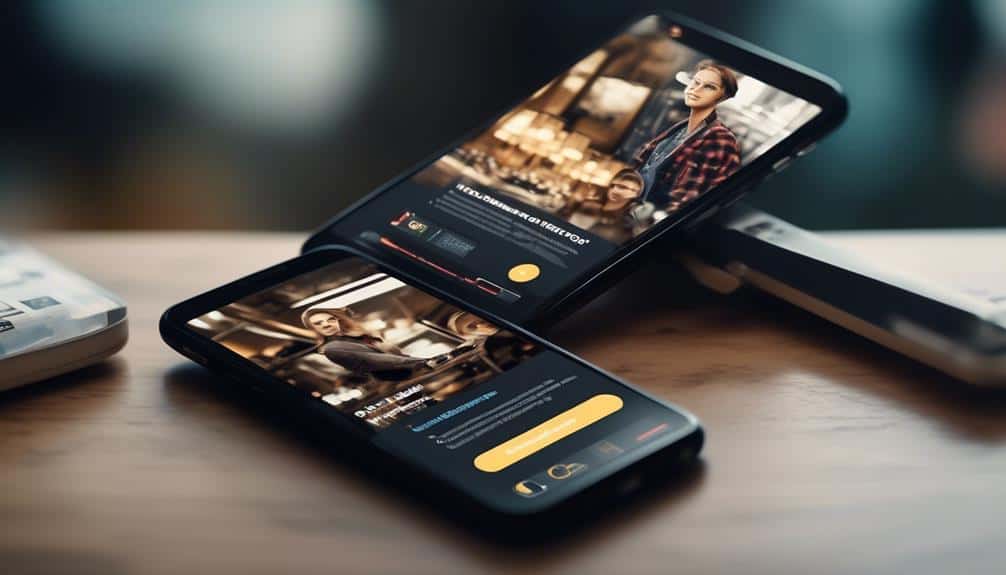Mobile Optimization: Crafting Landing Pages That Convert Across Devices
As you navigate the digital landscape, consider this: did you know that 53% of mobile site visits are abandoned if a page takes longer than three seconds to load?
Mobile optimization isn't just a buzzword; it's a crucial component of your online success. The way your landing pages perform on various devices can make or break your conversion rates.
Understanding the intricacies of crafting landing pages that not only adapt but excel across different screens is vital.
So, how can you ensure your pages are optimized for mobile devices?
Key Takeaways
- Prioritize mobile optimization for seamless user experiences and increased engagement.
- Implement responsive design principles to ensure cross-device compatibility and drive better conversions.
- Develop flexible layout designs that adapt to various screen sizes for wider audience reach.
- Streamline content development by optimizing for mobile, maintaining consistency, and using data-driven strategies for user engagement and conversions.
Importance of Mobile Optimization

Mobile optimization isn't just a trend but a crucial necessity in today's digital landscape, ensuring seamless user experiences across various devices. With the exponential growth of mobile traffic accounting for a significant portion of online visits, optimizing your site for mobile is no longer optional. User engagement is directly impacted by the mobile-friendliness of your website. Studies show that users are more likely to engage with a site that offers a smooth and responsive mobile experience.
When your landing pages aren't optimized for mobile, you risk losing potential customers due to a poor user experience. Slow loading times, distorted layouts, and difficult navigation can deter users from exploring your content and taking desired actions. By prioritizing mobile optimization, you not only enhance user engagement but also increase the likelihood of conversions.
Investing in mobile optimization strategies is a strategic move to align with the preferences of today's consumers who expect a seamless browsing experience regardless of the device they're using.
Responsive Design Principles
You must prioritize flexible layout design to ensure your landing pages adapt seamlessly across devices.
By embracing responsive design principles, you guarantee cross-device compatibility, which is crucial for engaging users on various screens.
Implementing these strategies will enhance user experience and drive better conversion rates.
Flexible Layout Design
Implementing a flexible layout design that adapts seamlessly to various screen sizes and orientations is crucial for enhancing user experience and maximizing conversion rates on your landing pages. By embracing adaptive design principles and adopting a mobile-first approach, you ensure that your content isn't only visually appealing but also easily accessible across different devices.
This strategic approach allows you to capture a wider audience and deliver a consistent message regardless of the device they're using. With a flexible layout design, you can optimize the user journey, streamline navigation, and ultimately drive conversions.
Stay ahead of the curve by prioritizing a responsive design that caters to the evolving landscape of mobile devices, setting the stage for increased engagement and success.
Cross-Device Compatibility
To ensure seamless user experience across all devices, prioritize responsive design principles that adapt to varying screen sizes and orientations. With mobile trends constantly evolving, understanding user behavior and conducting thorough device testing is crucial. Screen sizes differ across smartphones, tablets, and desktops, making cross-device compatibility a key factor in optimizing landing pages.
By implementing responsive design techniques, such as fluid grids and flexible images, you can ensure that your content displays correctly on any screen. Consider the layout and functionality of your landing pages to cater to diverse devices without compromising user experience.
Stay ahead of the curve by staying attuned to the latest mobile trends and continuously testing your pages on various devices to guarantee compatibility and engagement.
Streamlined Content Development

In crafting optimized landing pages for various devices, content development must be streamlined for effective engagement and conversion. To ensure your content resonates with users and drives conversions, consider the following streamlined content development strategies:
- Data-Driven Content Selection: Use analytics to understand user behavior and preferences, allowing you to create content that aligns with their needs and interests.
- Visual Hierarchy Optimization: Implement UX design principles to prioritize content based on importance, guiding users through the page and highlighting key information effectively.
- Consistent Brand Messaging: Maintain a cohesive content strategy across all devices to reinforce brand identity and build trust with your audience.
- Mobile-Friendly Formatting: Optimize content for mobile devices by using concise language, clear headings, and strategic formatting to ensure a seamless user experience across different screen sizes.
Call-to-Action Strategies
Crafting optimized landing pages for various devices requires strategic placement of compelling call-to-action strategies to prompt user engagement and drive conversions effectively. When it comes to call-to-action (CTA) buttons, their design plays a crucial role in influencing conversion rates. A/B testing different button designs can provide valuable insights into what resonates best with your audience. Copywriting is another essential element to consider. Crafting persuasive and action-oriented copy can significantly impact the effectiveness of your CTAs.
Visual hierarchy is key in guiding users' attention towards the CTA. Utilizing contrasting colors, bold fonts, or strategic placement can help draw the eye to the desired action. Additionally, incorporating directional cues like arrows or images pointing towards the CTA can further enhance its visibility. Remember, the goal is to make the CTA stand out without overwhelming the page. By strategically combining button design, copywriting, and visual hierarchy, you can create a compelling call-to-action that drives user engagement and boosts conversion rates across devices.
Speed and Performance Enhancements

Enhancing the speed and performance of your landing pages is paramount for maximizing user engagement and conversion rates across all devices. To achieve optimal results, consider the following strategies:
- Image compression: Reduce image file sizes without compromising quality using advanced compression techniques. This ensures faster loading times and smoother user experiences.
- Caching techniques: Implement browser caching to store frequently accessed resources locally, reducing server load and speeding up page loading for returning visitors.
- Lazy loading: Prioritize loading critical page elements first while deferring non-essential content until needed. This enhances initial load times and allows for a more seamless user interaction.
- Resource minimization: Streamline CSS and JavaScript files, remove unnecessary plugins, and prioritize content above-the-fold to minimize HTTP requests and boost page speed significantly.
A/B Testing and Optimization
You're about to embark on a journey of optimization through A/B testing. Test different page elements and meticulously analyze conversion rates to fine-tune your landing pages.
Test Page Elements
To optimize your landing pages effectively, test page elements through A/B testing and optimization to enhance user experience and drive conversion rates.
- A/B Testing: Compare different versions of your page layout to see which one resonates best with users.
- Call-to-Action Buttons: Experiment with colors, text, and placement to increase user engagement.
- Images and Videos: Test various media types to determine what captures attention and boosts conversions.
- Form Fields: Simplify or reorganize form fields to reduce friction and encourage more submissions.
Analyze Conversion Rates
Analyze your conversion rates through A/B testing and optimization to pinpoint strategies that maximize user engagement and drive higher conversion rates. By tracking conversion metrics and user behavior analysis, you can uncover trends that inform your optimization efforts. A/B testing allows you to experiment with different elements on your landing pages to see which combination yields the best results. Below is a table showcasing how this process can be structured:
| Element | A/B Test Variation A | A/B Test Variation B | Result |
|---|---|---|---|
| Call to Action | Green Button | Red Button | Red Button |
| Headline | Short & Direct | Long & Descriptive | Short & Direct |
| Image Selection | People | Product | Product |
| Form Length | 4 Fields | 6 Fields | 4 Fields |
User Experience (UX) Considerations

How can we enhance the user experience on landing pages across various devices for optimal engagement and conversions? To ensure a seamless experience, consider the following:
- Navigation Options: Provide intuitive navigation options that are easy to access and understand. Implement clear menus, search bars, and calls-to-action to guide users effectively.
- Design: Opt for a responsive design that adapts to different screen sizes and orientations. Prioritize simplicity in layout and use contrasting colors to highlight important elements.
- Visual Hierarchy: Arrange content in a visually appealing manner that guides users' attention towards key information. Utilize headings, fonts, and white space strategically to enhance readability.
- Accessibility: Make sure your landing pages are accessible to all users, including those with disabilities. Use alt text for images, ensure proper color contrast, and provide text alternatives for multimedia content.
Frequently Asked Questions
How Can I Ensure My Landing Pages Are Optimized for Both Ios and Android Devices?
Ensure your landing pages are optimized for iOS and Android. Test user experience across devices. Use clear call to actions and adapt layout for different screens. By testing and tweaking, you'll boost conversions effectively.
Are There Any Specific Design Trends or Elements That Are Proven to Increase Conversion Rates on Mobile Devices?
To boost conversion rates on mobile, implement responsive design for seamless user experience. Strategically place call to action buttons where they're easily accessible. Data shows these elements drive engagement and ultimately increase conversions on various devices.
How Can I Track the Effectiveness of My Mobile Landing Pages and Make Data-Driven Decisions for Optimization?
Track your mobile landing pages' effectiveness with conversion tracking and A/B testing. Analyze user engagement through heatmap analysis. Make data-driven decisions for optimization. Implement changes strategically to enhance conversion rates and improve overall performance.
What Are Some Common Pitfalls to Avoid When Optimizing Landing Pages for Mobile Users?
Improve user experience on mobile landing pages by focusing on functionality, load times, and navigation. Avoid common pitfalls like slow load times, cluttered layouts, and complex navigation. Optimize for seamless interaction to boost conversions.
How Can I Ensure a Seamless Transition for Users From Clicking on an Ad to Landing on My Mobile-Optimized Page?
To ensure a seamless transition for users from clicking on an ad to landing on your mobile-optimized page, focus on user experience and quick load times. Strategically place your call to action and prioritize readability for maximum impact.
Conclusion
In conclusion, optimizing your landing pages for mobile devices is crucial for driving conversions and maximizing ROI.
By implementing responsive design principles, crafting streamlined content, using effective call-to-action strategies, improving speed and performance, conducting A/B testing, and focusing on user experience, you can create high-converting landing pages that resonate with your audience across all devices.
Stay ahead of the competition by prioritizing mobile optimization in your digital marketing strategy.







